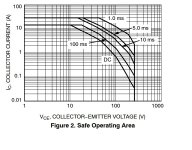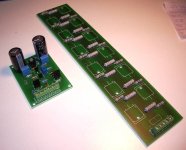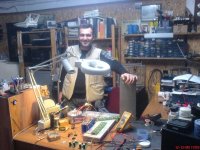Hi everyone .
Do you think it is possible to turn any ground referenced stereo power amplifier into a bridge amplifier using
the following totally differential OPAMP ? . for example I have a my-ref .
Thank you
https://www.ti.com/lit/ds/symlink/opa1632.pdf?ts=1687362270520
Do you think it is possible to turn any ground referenced stereo power amplifier into a bridge amplifier using
the following totally differential OPAMP ? . for example I have a my-ref .
Thank you
https://www.ti.com/lit/ds/symlink/opa1632.pdf?ts=1687362270520
If you bridge you reduce the load impedance seen by the amp by a factor of two, so if the amp is only 4-ohm capable it will drive 8-ohms bridged, but not 4.
And by ground-referenced I presume you mean output is ground referenced.
Class D amps usually aren't ground-referenced, and even if they are might not bridge depending on the design.
The normal opamp inverter circuit can be used, nothing exotic is needed, but if you want differential inputs a fully differential input amp makes sense.
There are ways of combining amps as a bridge if the inverting input of the input stage is accessible - some chip amps do this.
And by ground-referenced I presume you mean output is ground referenced.
Class D amps usually aren't ground-referenced, and even if they are might not bridge depending on the design.
The normal opamp inverter circuit can be used, nothing exotic is needed, but if you want differential inputs a fully differential input amp makes sense.
There are ways of combining amps as a bridge if the inverting input of the input stage is accessible - some chip amps do this.
In theory: yes. In practice: see above posts.Hi everyone .
Do you think it is possible to turn any ground referenced stereo power amplifier into a bridge amplifier...
Transfoemer based solutions sound best to me, as the dont introduce self noise, isolate the ground path and provide excellent distortion performance on par with most solid state solutions, given the transformer design is decent.
You can bridge any amplifier with differential input using only a resistor. The resistor is from one output to the differential of the other amplifier. I think on ESP there is some examples.
I am not sure what you are asking, could you make a sketch of what you intend. If you have a differential output, from your DAC then I am sure that you could feed each into an amplifier, and it would appear as being bridged. When bridging amps, all you are really doing is driving each amplifier differentially, i.e. out of phase with the other amp. If the amps are already internally bridged, then I don't think you will achieve anything.
Looking at your data sheet, absolutely possible when connected as shown on the first page. That amplifier is fully differential and will be driving each of your power amps, so it will produce 4 x the power of a single power amp. However, the output impedance needs to be doubled else the signal may exceed the safe operation of the amp because you will double the output voltage swing.
As long and as much as the power supply permits. Most often, that's the limitation....so it will produce 4 x the power...
Can you show me a diagram? It's fine even drawn by hand.You can bridge any amplifier with differential input using only a resistor. The resistor is from one output to the differential of the other amplifier. I think on ESP there is some examples.
Here is a practical example. The output of the master amp is fed via a 33K resistor to the inverted input of the slave amp, while the slave amp's input is shorted to ground. The master and slave amp are identical.
In short, the output of the master amp is fed through the same resistor value as is in the normal feedback path. This is a very simple way of achieving a bridged amp, and many commercial amps get away with a simple bridged/non-bridged switch on the back of the amp. I am not sure but think that Bryston did it this way as well. You can also find an example of this method in ESP's website.
Take what Ostripper says above seriously. The amplifier has to have the capability to run the higher current, else you will simply fry them.
In short, the output of the master amp is fed through the same resistor value as is in the normal feedback path. This is a very simple way of achieving a bridged amp, and many commercial amps get away with a simple bridged/non-bridged switch on the back of the amp. I am not sure but think that Bryston did it this way as well. You can also find an example of this method in ESP's website.
Take what Ostripper says above seriously. The amplifier has to have the capability to run the higher current, else you will simply fry them.
Attachments
Last edited:
A diagram of the same. The output across the speaker would be twice that of normal operation since they run out of phase, and therefore the power would 4x that of the stereo amplifier.
Attachments
Last edited:
There may have been some tweaks over the years, but attached is the original schematic. There is really no need to bridge this amplifier, it was just something interesting that was asked on this forum many years ago. I tried it, it worked and that was it, been there done it.
Before anyone comments that I should have done this or that, I am not revisiting something that has been archived since 2010, and I happen to have the data at hand on an old CD and just shared it for interest’s sake.
Sorry this amp was never featured here but on DIYAudio Turkey
Before anyone comments that I should have done this or that, I am not revisiting something that has been archived since 2010, and I happen to have the data at hand on an old CD and just shared it for interest’s sake.
Sorry this amp was never featured here but on DIYAudio Turkey
Attachments
Last edited:
Something I should mention from experience over the past 50 plus years. No matter how good you think a typical amplifier sounds, raw power even if you never go above 10 watt always sound better. You remain in the linear portion of the amplifier and it is just better sound, I don't care if it is a $30K jewellery 20 watt amplifier that boasts fantastic specifications - power beats everything.
That's a big 'given', measured in $ and weight - an opamp's cheap, an opamp's small/light, an opamp doesn't need magnetic shielding.Transfoemer based solutions sound best to me, as the dont introduce self noise, isolate the ground path and provide excellent distortion performance on par with most solid state solutions, given the transformer design is decent.
But the ground isolation is an attractive prospect, though you have to worry about impedance matching a lot more with transformers.
- Home
- Amplifiers
- Solid State
- stereo to bridge amplifier transformation



